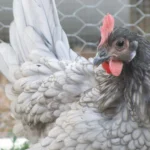All educational & Resource Articles Are Submitted By Volunteers
Molting is a natural process in which birds shed and regrow their feathers, and chickens are no exception. While it’s a vital part of their life cycle, molting isn’t always a pretty sight. Many people mistake molting for illness or bullying within the flock, especially during a rough molt. With over 10,000+ feathers to replace, it’s no wonder this process can be challenging for chickens.
Chickens experience two types of molts: the juvenile molt and the annual molt. Let’s explore when molting occurs, how to support your chickens through it, and tips for managing the process effectively.
When Molting Occurs
The first molt, known as the juvenile molt, occurs between 4-12 weeks of a chicken’s life. During this time, they are constantly shedding and regrowing feathers as they mature. The annual molt, on the other hand, typically happens once a year, usually in the autumn. Chickens generally experience their first annual molt around 16-18 months of age. The shorter daylight hours of fall signal to the chickens that it’s time to regrow their feathers in preparation for the colder winter months.
While the annual molt is most common in the fall, other factors such as poor nutrition, lack of water, illness, bullying, or stress within the flock can trigger molting at any time of the year. Some birds will even start molting early or late, in this case, it can be totally random or caused by factors such as artificial lighting in their coop, artificial heat source inside their coop.
The duration of the annual molt varies widely, averaging 5-7 weeks, though it can be as short as 2 weeks or as long as 12 weeks. Older chickens often take longer to complete their molt compared to younger birds.
Why Molting Occurs
Many people don’t fully understand the purpose of molting, but it serves an essential and even beautiful purpose. Chickens are active creatures, and over time their feathers become worn, broken, and less effective. By the end of the year, their feathers may no longer provide adequate warmth for the colder months ahead. Molting allows chickens to shed these old, damaged feathers and replace them with fresh, shiny, strong ones that help keep them warm and protected.
While the molting process itself may not be pleasant to watch or experience, it’s far from pointless. Once it’s over, your chickens will look stunning and feel brand new!
How Molting Occurs
Most articles and books state that chickens typically start molting from the head and neck, with the process working its way downward. However, this isn’t always the case! Many chicken keepers have observed their birds starting to molt from their tails and moving upward, or even beginning with their saddle feathers. The truth is, every chicken molts differently and at their own time.


Signs of Molting
You may wonder if you’ll be able to notice your chickens molting and the answer is yes and no! It really varies from chicken to chicken. Some molt so fast, you will hardly notice, while others throw all their feathers off at once and are half-naked for weeks. Rarely will you get a completely bald chicken. You also will notice great amounts of feathers laying around their coop and run. Other signs of molting include:
- Decreased laying
- Hungrier birds
- Chickens that’ll start eating their own or other chickens’ feathers
- A suddenly distant flock
- Uninterested in activities
- Paler, smaller combs / floppy combs and waddles
How You Can Help
As you may have gathered from the information shared earlier, molting is a stressful and challenging process for a chicken’s body. Many flock owners wonder how they can support their birds through this demanding time. First and foremost, feathers are composed of approximately 85% protein, so when chickens lose their feathers, their bodies require an increased protein intake to regrow them.
In addition to the standard chicken feed you purchase from your local farm store, consider supplementing their diet with high-protein foods such as:
- Warm oatmeal
- Scrambled or hard-boiled eggs
- Table meat scraps
- Corn
- Steamed or raw peas
- Wet or dry dog food or cat food
- Tuna fish
- Block oil sunflower seeds
- Live or dried mealworms / crickets
- Soybean meal
- Soybean oil, Rice bran oil, Coconut oil, Olive oil, etc
- Apple Cider vinegar
Be sure to feed these supplements in moderation, as overfeeding can lead to issues such as malnutrition, diarrhea, and other health problems. If your molting chickens don’t get enough protein, they may become aggressive and start pecking at each other, even eating feathers from their flock-mates. There are also specially formulated feeds that can be found at your local farm store that are designed to support molting chickens, which can be fed in larger quantities.
Other ways to help your molting chickens also include:
- Not handling them often
- Make sure that they have enough roaming room in their pens / runs and access to their shelter and / or coop
- Have fresh water and plenty of protein-rich foods
Facts About Molting
- During the molt, hens typically stop laying eggs temporarily. The molting process demands a lot of energy and is highly stressful for chickens, especially due to the significant amount of protein needed to regrow their feathers. Roosters may also experience reduced fertility during this time.
- You might notice your flock seeming less active, less productive, and much hungrier than usual as they conserve energy to focus on feather regrowth.
- Once their molt is finished, your flock should return back to their normal behaviors and duties, but looking much vibrant!
- Molting doesn’t always occur in the fall for some chickens. Chickens have been known to molt in the spring, summer and even in winter.
- All chickens have a different molting pattern.
- Bullying and feather picking behaviors increase during their molts.
- Once their molt is completely finished, your chickens will look shiny and amazing!
Conclusion
Molting, whether light or heavy, is a stressful process for chickens and can last anywhere from 2 to 12 weeks. Each chicken molts differently and at its own pace. To successfully regrow their feathers, chickens require extra protein during this time.
Hens typically stop laying eggs during their molt, and roosters may experience reduced fertility. Be vigilant for signs of bullying or consistent feather-picking behaviors within the flock. By understanding the signs and needs of molting chickens, you can provide the care and support they need to get through this challenging phase.
Photos/pictures provided by Google
If you own any of the photos above and wish to have them removed, please email the rescue’s email.
Chicken Chickens Poultry health
Last modified: December 4, 2024










